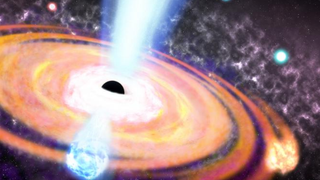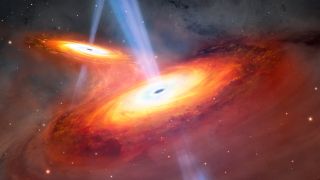Forget the “little green men”: it’s the “little red dots” in the nascent universe that have caught the attention of the James Webb Space Telescope (JWST).
Scientists say these strange red bodies hide stars that models suggest are “too old” to have lived in the earliest cosmic times and black holes that are thousands of times larger than the supermassive black hole at the heart of the Milky Way. Scientists think these objects must have been born in a way that was unique to the early universe, by a method that seems to have ceased in the cosmos after about 1 billion years of existence.
The three small red dots are visible as they were when the Universe was between 600 and 800 million years old. While this may seem like an extremely long time after the Big Bang, the fact that the Universe is 13.8 billion years old means that it was no more than 5% of its current age when these objects existed.
By confirming the existence of these points in the early universe, these JWST findings could challenge what we know about the evolution of galaxies and the supermassive black holes at their hearts.
Related: James Webb Space Telescope Observes Never-Before-Seen Star Behavior in Distant Nebula (Video, Photo)
The team, led by scientists from Penn State University, observed these mysterious crimson cosmic oddities while studying the early universe with JWST’s Near Infrared Spectrograph (NIRSpec) instrument as part of the RUBIES survey.
“It’s very puzzling,” team member Joel Leja, an assistant professor of astronomy and astrophysics at Penn State, said in a statement. “You can make it uncomfortable in our current model of the universe, but only if we’re talking about an exotic, incredibly rapid formation at the beginning of time.”
“This is without a doubt the most unique and interesting set of objects I have seen in my career.”
What’s behind the dots?
The researchers studied the intensity of different wavelengths of light coming from the small red dots and found signs that these stars were hundreds of millions of years old, much older than what is expected of stars at this early stage of the cosmos.
The researchers also observed evidence of supermassive black holes in the regions of the small red dots, which have masses equivalent to millions or even billions of suns. These black holes are between 100 and 1,000 times more massive than Sagittarius A* (Sgr A*), the supermassive black hole at the heart of the Milky Way, located just 26,000 light-years from Earth.
Both of these findings are not predictable according to current models of cosmic evolution, galaxy growth, or supermassive black hole formation. All of these theories suggest that galaxies and supermassive black holes grow at the same rate, but this growth takes billions of years.
“We confirmed that these objects appear to be filled with ancient stars—hundreds of millions of years old—in a universe that is only 600 to 800 million years old. These objects hold the record for the earliest signatures of light from ancient stars,” Bingjie Wang, a postdoctoral researcher at Penn State, said in the statement. “It was completely unexpected to find old stars in a very young universe. Standard models of cosmology and galaxy formation have been incredibly successful, but these luminous objects don’t quite fit into those theories.”

The team first spotted these small red dots using JWST last July. At the time, researchers immediately suspected that these objects were actually galaxies that existed about 13.5 billion years ago.
Further study of the light spectra of these objects confirmed that they were galaxies that lived at the dawn of time and also revealed that “invaded” supermassive black holes and incredibly “old” stars were powering the impressive light output of the red dots.
The team doesn’t yet know for sure how much of the light in the small red dots comes from each of these sources. That means these galaxies are either surprisingly old and more massive than the Milky Way, having formed much earlier than models predict, or they have normal mass but are in some way excessively massive black holes—voids that are much more massive than a similar galaxy would have at the current epoch of the cosmos.
“It is difficult to distinguish between light from matter falling into a black hole and light emitted by stars in these tiny, distant objects,” Wang said. “The inability to tell the difference in the current data leaves a lot of room for interpretation of these intriguing objects.”
This is no ordinary supermassive black hole!
Of course, all black holes have light-trapping boundaries called “event horizons,” meaning that whatever amount of light they bring to the little red dots must come from the matter around them rather than from inside.
The enormous gravitational influence of black holes generates turbulent conditions in this matter, which also feed the black hole over time, heating it and making it glow brightly. Regions fed in this way by supermassive black holes are called “quasars” and the regions of their galaxies in which they are found are known as “active galactic nuclei (AGN)”.
These newly discovered “red-spot” black hole regions may be different from other quasars, even those that JWST has already observed in the early universe. For example, red-spot black holes appear to produce much more ultraviolet light than expected. However, the most shocking thing about these supermassive black holes is their apparent mass.
“Normally, supermassive black holes are associated with galaxies,” Leja says. “They grow together and have all the big experiences of their lives together. But here we have a fully formed adult black hole living inside what should be a small galaxy.”
“It doesn’t really make sense, because these things should grow together, or at least that’s what we thought.”

Red dot galaxies are also surprising. They appear much smaller than other galaxies, even though they contain almost as many stars. This means that red dot galaxies appear to consist of 10 to 1 trillion stars packed into a galaxy a few hundred light-years across and 1,000 times smaller in volume than the Milky Way.
To put this in context, if the Milky Way were shrunk to the size of one of these red dot galaxies, then the closest star to the Sun (Proxima Centauri, which is 4.2 light-years away) would be in the solar system. Additionally, the distance between Earth and the Milky Way’s supermassive black hole, Sgr A*, would be reduced from 26,000 light-years to just 26 light-years. The black hole and its surroundings would then appear in the night sky above Earth.
“These early galaxies were so dense with stars — stars that must have formed in ways we’ve never seen, in conditions we never imagined at a time when we didn’t expect to see them,” Leja said. “And for some reason, the universe stopped creating objects like these after just a few billion years. They’re unique to the early universe.”
The team plans to continue observing these puzzling little red dots to better understand their mysteries. In particular, they plan to obtain deeper spectra by pointing the JWST at the red objects for extended periods of time to obtain spectra of light emission associated with various elements. This could help untangle the contributions of ancient stars and supermassive black holes in galaxies.
“There is another way to make a breakthrough, and that is simply to have the right idea,” Leja concludes. “We have all these pieces of the puzzle, and they only fit together if we ignore the fact that some of them break. This problem is likely to be solved by a stroke of genius that has so far eluded us, all our collaborators, and the entire scientific community.”
“Honestly, it’s exciting to have so much left to unravel in this mystery.”
The team’s research was published June 26 in the journal Astrophysical Journal Letters.